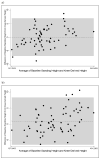Validity of Knee-Estimated Height to Assess Standing Height in Older Adults: A Secondary Longitudinal Analysis of the Mexican Health and Aging Study
- PMID: 28244564
- PMCID: PMC5749405
- DOI: 10.1007/s12603-016-0761-7
Validity of Knee-Estimated Height to Assess Standing Height in Older Adults: A Secondary Longitudinal Analysis of the Mexican Health and Aging Study
Abstract
Objective: The main objective was to test the validity of height estimated by knee height in Mexican older adults, as a surrogate for standing height.
Design: Cohort study.
Setting: Data were drawn from the first and third waves of the Mexican Health and Aging Study.
Participants: Included participants were community-dwelling 50-year or older adults with measured height at baseline and in follow-up. Subjects with a lower limb fracture in the follow-up were excluded.
Measurements: Main measurements were baseline standing height and 11-year follow-up and knee-estimated height in follow-up. Population specific equations were used to estimate standing height from knee height. Comparisons between baseline standing height and knee-derived height were done with simple correlations, limits of agreement (Bland-Altman plot) and Deming regressions.
Results: A total of 136 50-year or older adults were followed-up for eleven years, with a mean age of 60. There was a positive correlation between knee-estimated height and baseline standing height of 0.895 (p<0.001) for men and of 0.845 (p<0.001) for women. Limits of agreement for men were from -6.95cm to 7.09cm and for women from -6.58cm to 8.44cm.
Conclusion: According to our results, knee-estimated height could be used interchangeably with standing height in Mexican older adults, and these results might apply also to other populations.
Keywords: Body height; body mass index; geriatric assessment; validation.
Conflict of interest statement
Authors declare not to have conflict of interest.
Figures


Similar articles
-
Validity of measuring knee-height as an estimate of height in diseased French elderly persons.J Nutr Health Aging. 2004;8(5):386-8. J Nutr Health Aging. 2004. PMID: 15359357
-
[MODEL FOR ESTIMATING STANDING HEIGHT IN MEXICAN ADULTS FOR 20-59 YEARS, BASED ON KNEE LENGTH].Nutr Hosp. 2015 Dec 1;32(6):2855-61. doi: 10.3305/nh.2015.32.6.9850. Nutr Hosp. 2015. PMID: 26667744 Spanish.
-
Developing an equation for estimating body height from linear body measurements of Ethiopian adults.J Physiol Anthropol. 2018 Nov 26;37(1):26. doi: 10.1186/s40101-018-0185-7. J Physiol Anthropol. 2018. PMID: 30477567 Free PMC article.
-
Accuracy of equations for predicting stature from knee height, and assessment of statural loss in an older Italian population.J Gerontol A Biol Sci Med Sci. 2001 Jan;56(1):B3-7. doi: 10.1093/gerona/56.1.b3. J Gerontol A Biol Sci Med Sci. 2001. PMID: 11193222
-
Predictive equations for estimation of stature in Malaysian elderly people.Asia Pac J Clin Nutr. 2003;12(1):80-4. Asia Pac J Clin Nutr. 2003. PMID: 12737015
Cited by
-
Evaluation of an alternative skeletal muscle index for skeletal muscle mass assessment in a group of Australian women.Age Ageing. 2022 Feb 2;51(2):afac002. doi: 10.1093/ageing/afac002. Age Ageing. 2022. PMID: 35150589 Free PMC article.
-
Association between standing height and physical disability among U.S. adults aged 60 years and older: findings from NHANES 2015-2018.BMC Geriatr. 2024 Jun 18;24(1):529. doi: 10.1186/s12877-024-05100-3. BMC Geriatr. 2024. PMID: 38890578 Free PMC article.
-
Aflatoxin exposure and child nutrition: measuring anthropometric and long-bone growth over time in Nepal.Am J Clin Nutr. 2021 Apr 6;113(4):874-883. doi: 10.1093/ajcn/nqaa397. Am J Clin Nutr. 2021. PMID: 33677532 Free PMC article.
-
Longitudinal Analysis of Outpatient Physician Visits in the Oldest Old: Results of the AgeQualiDe Prospective Cohort Study.J Nutr Health Aging. 2018;22(6):689-694. doi: 10.1007/s12603-018-0997-5. J Nutr Health Aging. 2018. PMID: 29806857
References
-
- Tanner JM. Normal growth and techniques of growth assessment. Clin Endocrinol Metab. 1986;15(3):411–51. - PubMed
-
- Chumlea WC, Roche AF, Steinbaugh ML. Estimating stature from knee height for persons 60 to 90 years of age. J Am Geriatr Soc. 1985;33(2):116–20. - PubMed
-
- Mendoza-Nunez VM, Sanchez-Rodriguez MA, Cervantes-Sandoval A, Correa-Munoz E, Vargas-Guadarrama LA. Equations for predicting height for elderly Mexican Americans are not applicable for elderly Mexicans. American journal of human biology : the official journal of the Human Biology Council. 2002;14(3):351–5. doi: 10.1002/ajhb.10029. - DOI - PubMed
MeSH terms
Grants and funding
LinkOut - more resources
Full Text Sources
Other Literature Sources

